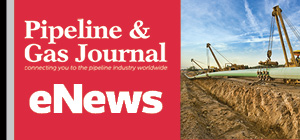
Current Issue: May 2025, Vol. 252, No. 5
Editor's Notebook
Editor-in-Chief Michael Reed explores the growing challenges facing the midstream workforce, including the looming retirement wave and how companies are responding through mentorship, partnerships, and emerging technologies.
Features
A new workforce census from the Engineering Construction Industry Training Board reveals that the UK oil and gas sector faces mounting workforce challenges due to an aging labor pool, low recruitment of women and young people, and difficulty filling site-based roles.
A gas pipeline between Malta and Italy has become one of the EU’s most contentious energy projects — with ties to scandal, climate backlash, and high-stakes political pressure. What’s really behind the Melita pipeline debate?
In this midyear outlook, P&GJ Editor-in-Chief Michael Reed highlights major pipeline projects in the Permian and Haynesville that signal growth in natural gas infrastructure. With LNG demand and political momentum driving new construction, optimism is returning to the U.S. midstream sector—even as permitting challenges persist.
Experts see a midstream resurgence in North Dakota’s Bakken region, citing increased oil and gas production, pipeline expansions, and long-term infrastructure planning.
As President Trump’s administration signals support for domestic energy, midstream leaders in the Marcellus and Appalachian region push for permitting reform, expanded pipeline infrastructure, and policy changes to drive oil and gas growth.
California regulators are developing a plan to close the Aliso Canyon gas storage site, years after the nation’s worst methane leak. What does it mean for energy storage and the future of gas?
Filtration plays a critical role in carbon capture, utilization, and storage (CCUS) by enhancing CO2 purity, protecting equipment, and improving operational efficiency across all stages—from capture to compression and injection.
Four major pipeline projects across Brazil, Argentina, and Bolivia are expanding South America's midstream capacity in 2025, including natural gas and crude oil infrastructure developments.
Global News
Stay informed with the latest industry news and developments in the midstream sector. From pipeline projects to regulatory updates and company announcements, P&GJ's Global News column brings you the most important insights from around the world.
Projects
Glenfarne takes over Alaska LNG pipeline project; Fluxys begins work on Belgium’s first hydrogen pipeline; Czech Republic boosts oil imports via expanded TAL line; TC Energy joins call to fast-track Canadian pipeline projects; Phillips 66 plans 300 MMcf/d gas plant in the Permian — and much more!

- Kinder Morgan Proposes 290-Mile Gas Pipeline Expansion Spanning Three States
- Valero Plans to Shut California Refinery, Takes $1.1 Billion Hit
- Three Killed, Two Injured in Accident at LNG Construction Site in Texas
- Tallgrass to Build New Permian-to-Rockies Pipeline, Targets 2028 Startup with 2.4 Bcf Capacity
- TC Energy Approves $900 Million Northwoods Pipeline Expansion for U.S. Midwest
- U.S. Pipeline Expansion to Add 99 Bcf/d, Mostly for LNG Export, Report Finds
- US Poised to Become Net Exporter of Crude Oil in 2023
- EIG’s MidOcean Energy Acquires 20% Stake in Peru LNG, Including 254-Mile Pipeline
- Construction Begins on Ghana's $12 Billion Petroleum Hub, But Not Without Doubts
- Valero Plans to Shut California Refinery, Takes $1.1 Billion Hit


